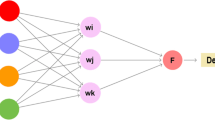Abstract
Traffic congestion is caused by inefficient road operations and by excess demand of the travelers. Various researchers have submitted different recommendations for resolving the traffic congestions and for providing optimum routes to travel from a particular origin to the specified destination with less time and less fuel consumption. Historical traffic data has been used in traffic recommendation systems to present optimum travel routes to road users. The process of finding the optimum navigational path for a particular route is the personalization of the transportation system. The personalization makes the transportation into an intelligent transportation system (ITS). The intelligent transportation system stores the frequent traveler’s optimal path to travel from any source to the destination on a particular day at a particular time in the database. The artificial neural network (ANN) is then used for data analysis for making predications in various domains. The optimum path is the path which takes the least travel time with least fuel consumption. The personalized intelligent system assists travelers with the optimum path using the PrefixSpan algorithm.
Access this chapter
Tax calculation will be finalised at checkout
Purchases are for personal use only
Similar content being viewed by others
References
S. Lee, Y. Kim, Intelligent traffic control for autonomous vehicle systems based on Machine Learning. Exp. Syst. Appl. 144 (2020). https://doi.org/10.1016/j.esw.2019.113074
M.M. Hamdi, L. Audah, A.J. Rashid, A review of applications, characteristics and challenges in vehicle ad hoc network (VANETS). IEEE Xplore, HORA (2020). INSPEC Accession Number: 19970560. https://doi.org/10.1109/HORA49412.2020.9152928
Z.K. Peng, Z. Liang, A deep Learning based multitask model for network—wide traffic speed prediction. Neuro Comput. 396, 438–450 (2020). https://doi.org/10.1016/j.neucom.2018.10.097
H.M. Kammoun, I. Kallel, J. Casillas, A. Abraham, A.M. Alimi, Adapt-Traf: an adaptive multi agent road traffic management system based on hybrid anti-hierarchical fuzzy model. Transp. Res. Part C Emerg. Technol. 42, 147–167 (2014). https://doi.org/10.11016/j.trc.2014.03.003
E.I. Viahogianni, M.G. Karlaftis, J.C. Golias, Short-term traffic forecasting: where we are and where are we going. Transp. Res. Part Emerg. Technol. 43(Part 1), 3–19 (2014). https://doi.org/10.1016/j.trc.2014.01.005
G. Aloysius, D. Binu, An approach to product placement in supermarket using the Prefix span algorithm. J. King Saudi Univ. Comput. Inform. Sci. 25, 77–87 (2013)
X. Wang, Z. Ning, X. Xu, E.C.-H. Nagai, A city—wide real-time traffic management systems: enabling crowdsensing in social internet of vehicle. IEEE Commun. Mag. 56(9), 19–25 (2018).https://doi.org/10.1109/MCOM.2018/1701065
B. Maram, J.M. Gnanasekar, G. Manogaran, M. Balaanand, Intelligent security algorithm for UNICODE data privacy and security in IOT. SOCA 13(1), 3–15 (2018). https://doi.org/10.1007/s11761-018-0249-x
B.H. Liu, N.T. Nguyen, V.T. Pham, An efficient method for sweep coverage with minimum mobile sensor, in 2014 Tenth International Conference on Intelligent Information Hiding and Multimedia Signal Processing, Kitakyushu, Japan (2014), pp. 289–292. https://doi.org/10.1109/IIH-MSP.2014.78
S. Muruganandam, N. Srinivasan, Personalizing e-learning system for courses using prefix span algorithm. J. Theor. Appl. Inform. Technol. 74(2) (2015). ISSN 1992-8645, www.jatit.org, E-ISSN 1817-3195
A.A.K. Skiy, P. Xariya, Traffic management: an outlook. Econ. Transp. 4(3), 135–146 (2015). https://doi.org/10.1016/jecotra.2015,03.002
P.R. Chowdhary, S. Das, Automatic road management system in a city. STM J. 38–46 (2014). TTEA
L. Lu, J. Yu, A real-time personalized route recommendation system for self-drive tourist based on vehicle to vehicle communication. Exp. Syst. Appl. 4(7), 3409―3417 (2014)
S.N. Lanke, Smart traffic management system. Int. J. Comput. Appl. 75(1), 109 (2013) (0975-8887)
Author information
Authors and Affiliations
Editor information
Editors and Affiliations
Rights and permissions
Copyright information
© 2022 The Author(s), under exclusive license to Springer Nature Singapore Pte Ltd.
About this paper
Cite this paper
Muruganandam, S., Ananthapadmanaban, K.R., Srinivasan, S. (2022). An Intelligent Road Transportation System. In: Manogaran, G., Shanthini, A., Vadivu, G. (eds) Proceedings of International Conference on Deep Learning, Computing and Intelligence. Advances in Intelligent Systems and Computing, vol 1396. Springer, Singapore. https://doi.org/10.1007/978-981-16-5652-1_4
Download citation
DOI: https://doi.org/10.1007/978-981-16-5652-1_4
Published:
Publisher Name: Springer, Singapore
Print ISBN: 978-981-16-5651-4
Online ISBN: 978-981-16-5652-1
eBook Packages: Intelligent Technologies and RoboticsIntelligent Technologies and Robotics (R0)




